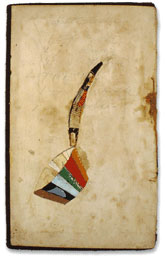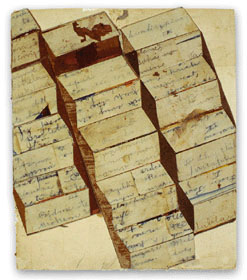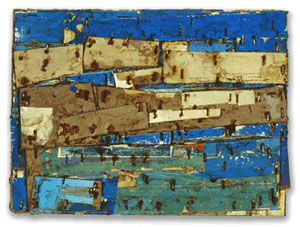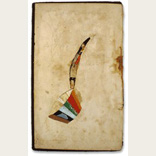Lance Letscher’s recent work at Howard Scott Gallery in New York city is a testament to the fact that art needn”t be rich in concept to be visually pleasing. With a hefty dose of nostalgia and a pinch of romanticism, the artist turns secondhand scraps of paper into abstracted landscapes. Favoring stained papers and fraying book covers, the nostalgia is not for the distinctive brand of found objects, but rather for an era long past. One gets the impression that Letscher writes his letters by hand, takes the train instead of a plane, and reads the headlines in print rather than online.
This must be a place where Letscher is content to operate. His affinity for used paper is as obvious as his keen eye for color. However, one can’t help but wonder how his work would function were it made solely with new construction paper. Most likely a piece like Steps would lose its the tattered appeal and resemble the work of a first term design student. Therein lies the problem: Letscher’s reliance upon reincarnate materials silences the strength of the manner in which he handles them. Obsessive in every detail, he meticulously cuts, pastes, and composes works that would be comfortable in an antique shop.
The conviction of Letscher’s work coincides with the morality of the materials to achieve a somber mood that indicates the artist is aching with something to be said. Stars collaged with moons and constellations cause works like Dipper to walk the line between a simple aesthetic experience and all things metaphysical. Letscher seems to be pondering (both in his own practice and in our anticipated viewer response) whether one can have a purely aesthetic experience apart from religiosity. The works beckon for the viewer to slow down, look closer, and remember. But if there is indeed something being said, it is spoken very softly.
Letscher has adopted as his primary focus a medium that has historically been used by artists for tertiary purposes. His body of work is a sincere endeavor, but it leaves one wondering if these pieces are sketches for other, bolder gestures. In the manner that Ellsworth Kelly collaged a magazine photo of a breast onto a snapshot of a hillside, Letscher should consider the impact that a larger, more substantial work might have. In an age of aesthetic pluralism, to simply make collages is accepted. But it is difficult to understand why an artist with such fine sensibilities would choose to limit himself to a second rate medium. There is a wider audience eager to listen if Letscher will only make the leap.
Perhaps Letscher is content with the formal elements of making art. If this is the case, the work falls startlingly short in its lack of content. Although it would be a misjudgment to assume that his goals are inline with such design-heavy painters as Sol LeWitt, there is a case to be made for a connection to that lineage. Letscher’s commitment to collage in today’s art climate could easily be interpreted as a reaction to the media-heavy works championed by galleries all along the same street as his. Either courageous, misinformed, or boldly stubborn, his commitment to collage reveals a bit about both his political stance and his overall motivation for making art.
The artist’s monetary investment in each work is one dollar, maybe two. This is assuming that Letscher spends time rummaging around secondhand stores as opposed to trash dumpsters. This sort of aesthetic capitalism is interesting to consider: a book cover here, a torn page there, some glue and shellac all retails for nearly two grand. With very little material expense, Letscher must enjoy the comfort of high profits and low overhead.
![]()
This is not to suggest that a romantic like Letscher would be commercially motivated, although his work might be more interesting if he were. If it were apparent that he considered such facets of his production, then he could be praised for asserting the roots of artistic objects as commodity in contemporary American art. Such irreverence, I am certain, would make an artist like Letscher cringe. So for now, interested philanthropists can be assured that there are many more lovely collages to come from a studio that must be haunted by the ghost of Joseph Cornell.
Lance Letscher’s work can currently be viewed at McMurtrey Gallery in Houston (through June 1, 2002) and Conduit Gallery in Dallas (through June 15, 2002).
All images are courtesy of the artist and Howard Scott Gallery, New York, NY.
C. Sean Horton is an artist living in Allston, MA.






